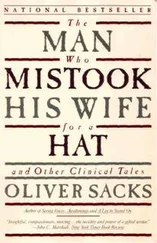In 1899, Gabriel Anton described a singular syndrome in which patients totally blind from cortical damage (usually from a stroke affecting the occipital lobes on both sides) seemed to be unaware of it. Such patients may be sane and intact in all other ways, but they will insist that they can see perfectly well. They will even behave as if sighted, boldly walking in unfamiliar places. If, in so doing, they collide with a piece of furniture, they will insist that the furniture has been moved, that the room is poorly lit, and so on. A patient with Anton’s syndrome, if asked, will describe a stranger in the room by providing a fluent and confident, though entirely incorrect, description. No argument, no evidence, no appeal to reason or common sense is of the slightest use.
It is not clear why Anton’s syndrome should produce such erroneous but unshakable beliefs. There are similar irrefutable beliefs in patients who lose the perception of their left side and the left side of space but maintain that there is nothing missing, even though we can demonstrate convincingly that they live in a hemi-universe. Such syndromes — so-called anosognosias — occur only with damage to the right half of the brain, which seems to be especially concerned with the sense of bodily identity.
An even stranger twist was given to the matter in 1984, with the publication of a paper by Barbara E. Swartz and John C. M. Brust. Their patient was an intelligent man who had lost the sight in both eyes from retinal injuries. Normally, he recognized that he was blind and behaved as if blind. But he was also an alcoholic, and twice, while on a drinking binge, he believed that his sight had returned. Swartz and Brust wrote:
During these episodes, he believed he could see; for example, he would walk about without asking for assistance, or he would watch television, and he claimed he could then discuss the program with friends.… [He] could not read the 20/800 line on a visual acuity chart, or detect a bright light or hand movements in front of his left eye. Nonetheless, he claimed that he could see, and in response to questions he offered plausible confabulations — for example describing the examining room or the appearance of the two physicians with whom he was speaking. In many particulars his descriptions were wrong, but he did not recognize that they were wrong. However, he did admit that he was also seeing things that were not really there. For example, he described the examining room as being full of little children, all wearing similar attire, some of whom were walking in and out of the room through the walls. He also described a dog in the corner eating a bone, and then noted that the walls and the floor of the room were orange. The children, dog and wall colors he recognized as hallucinations, but [he] insisted that his other visual experiences were real.
Returning to Gordon H., I would hazard a guess that damage to the right occipital lobe has produced a unilateral Anton’s syndrome (though I do not know if such a syndrome has ever been described). His hallucinations (unlike those of Lance’s patients) are informed and shaped by what he perceives in the intact part of his visual field, and mesh seamlessly with his intact perception to the right.
Mr. H. has only to turn his head to discover that he has been deceived, but this does not shake his conviction that he can see equally to both sides. He may, if pressed, accept the term “hallucination,” but if he does so he must feel that, for him, hallucination is veridical, that he is hallucinating reality.
As a medical student at the Middlesex Hospital in London in the 1950s, I saw many patients with delirium, states of fluctuating consciousness sometimes caused by infections with high fevers or by problems like kidney or liver failure, lung disease, or poorly controlled diabetes, all of which may produce drastic changes in blood chemistry. Some patients were delirious from medications, especially those receiving morphine or other opiates for pain. Patients with delirium were almost always on medical or surgical wards, not on neurological or psychiatric wards, for delirium generally indicates a medical problem, a consequence of something affecting the whole body, including the brain, and it disappears as soon as the medical problem has been righted.
It may be that age, even when there is full intellectual function, increases the risk of hallucinations or delirium in response to medical problems and medication — especially with the polypharmacy so often practiced in medicine today. Working in a number of old-age homes, I sometimes see patients on a dozen or more different medications, which are liable to interact with one another in complex ways and, not uncommonly, tip the patients into delirium. 53 53 In addition to the overt delirium that may be associated with life-threatening medical problems, it is not uncommon for people to have slight delirium, so mild that it would not occur to them to consult a physician, and which they themselves may disregard or forget. Gowers, in 1907, wrote that migraine is “often attended by quiet delirium of which nothing can be subsequently recalled.” There has always been inconsistency in defining delirium, and as Dimitrios Adamis and his colleagues pointed out in their review of the subject, it has frequently been confused with dementia and other conditions. Hippocrates, they wrote, “used about sixteen words to refer to and name the clinical syndrome which we now call delirium.” There was additional confusion with the medicalization of insanity in the nineteenth century, as German Berrios has noted, so that insanity was referred to as délire chronique . Even now the terminology is ambiguous, so that delirium is sometimes called “toxic psychosis.”
We had one patient on a medical ward at the Middlesex Hospital, Gerald P., who was dying from kidney failure — his kidneys could no longer clear the toxic levels of urea building up in his blood, and he was delirious. Mr. P. had spent much of his life supervising tea plantations in Ceylon. I read this in his chart, but I could have gathered it from what he said in his delirium, for he talked nonstop, with wild associational leaps from one thought to another. My professor had said he was “talking nonsense,” and at first I could make little sense of what he was saying — but the more I listened, the more I understood. I started spending as much time as I could with him, sometimes two or three hours a day. I began to see how fact and fantasy were admixed in the hieroglyphic form of his delirium, how he was reliving and at times hallucinating the events and passions of a long and varied life. It was like being privy to a dream. At first he talked to no one in particular; but once I started to ask him questions, he responded. I think he was glad that someone was listening; he became less agitated, more coherent in his delirium. He died peacefully a few days later.
In 1966, when I started practice as a young neurologist, I began working at Beth Abraham Hospital in the Bronx, a home for those with chronic diseases. One patient there, Michael F., was an intelligent man who, besides other problems, had a very damaged, cirrhotic liver, the result of a severe hepatitis infection. The little liver he had left could not cope with a normal diet, and his protein intake had to be strictly limited. Michael found this hard to take, and every so often he “cheated” by eating some cheese, which he adored. But one day, it seemed, he went too far, for he was found in a near coma. I was called at once, and when I arrived, I found Mr. F. in an extraordinary state, alternating between stupor and delirious agitation. There were brief periods when he would “come together” and show insight into what was going on. “I’m out of this world,” he said at one point. “I’m stoned on protein.”
Читать дальше












